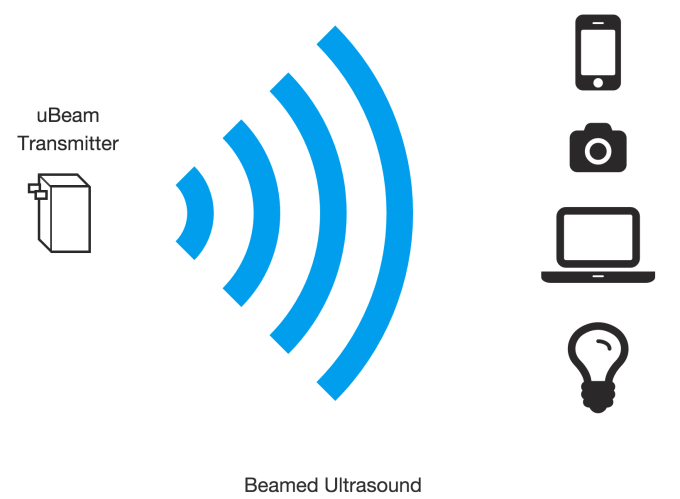 What if wireless power at a distance actually worked? It does. uBeam invented a way to wirelessly send energy up to 15 feet away with ultrasound.
What if wireless power at a distance actually worked? It does. uBeam invented a way to wirelessly send energy up to 15 feet away with ultrasound.What if you could slap a wireless charging case on your phone and charge it while you move around or use it? uBeam invented that too. While early uBeam prototype were massive, non-portable boxes that merely shot power around, it now has a working version that consumers would want.
And what if your phone could wirelessly charge while you’re at Starbucks because they installed the transmitters? You’d probably be more likely to stop by.
That’s why sources confirm to TechCrunch that major brands are vying to become strategic investors of uBeam in hopes of scoring exclusivity deals so they’ll be the first retail locations to offer uBeam wireless charging. uBeam is seeking exclusive partnerships with the #1 players in several retail verticals.
Starbucks is said to be especially near to striking deals to join a strategic investor round that will close soon, and uBeam is also in talks with the top names like Virgin in air travel, Starwood hotels, and some huge fast food chains. uBeam has also spoken with leading hardware manufacturers like Apple and Samsung.

uBeam’s case will wirelessly charge phones
When asked, uBeam declined to comment on this article.
The new money would add to the $10 million Series A led by Upfront Ventures that uBeam raised in October, which also included many investors from its $3.2 million in seed rounds such as Andreessen Horowitz, Founders Fund, Ludlow Ventures, CrunchFund (run by TechCrunch’s founder), Troy Carter, Shawn Fanning, Mark Cuban, Ken Seiff, Ellen Levy, and Tony Hsieh.
A lot of smart people believe.
Wireless Power Via Ultrasound
Plenty of other companies have tried and failed to produce true wireless power, with some ending up doing magnetic resonance charging. But that requires devices to be so close to transmitters or even touching, so they may as well be plugged in. It’s linear innovation, not exponential innovation.However, the buzz amongst prestigious funds is that after due diligence research, many think uBeam’s style of wireless charging will work for consumers and could have utterly massive potential.

A bulky early uBeam transmitter prototype
uBeam’s ultrasound wireless charging has several advantages. First and foremost, it’s safe. These are similar ultrasonic waves used for ultrasound scans of babies in the womb. The receivers are cheap, possibly costing around $50 or less a source says, and slim, so they’re not annoying to attach to your phone. The same waves can also transmit data, which could turn uBeam into a way to connect Internet Of Things devices.
But what makes it so attractive to consumers will be that devices can charge at a distance of around 15 feet (though that could improve), even while a device is moving. That means you could carry your phone around and use it in a room outfitted with transmitters, and see your battery percentage grow.

Death To Cords
Wireless charging cases could free people from hunching by electrical outlets and rationing their energy all day. While smartphones have gotten progressively more slim and powerful, battery life has struggled to keep up. That’s not only a drain on satisfaction with smartphones, it stifles the entire mobile economy as a lack of power keeps people from downloading apps, shopping, or using on-demand services. uBeam could provide economic stimulus along with the delight and convenience people will pay for.
uBeam CEO Meredith Perry [by Paul Mauer]
But long-term, if uBeam’s wireless charging protocol reaches its full potential, it could be the death of the power cord. Not just for phones, but for an extraordinarily wide array of electronics. Anywhere you see a charging cord, just imagine uBeam’s technology inside the device instead.
To be clear, uBeam is still working on a hard science problem where unexpected setbacks can happen. There are plenty of reasons it might not be able to get as cheap, powerful, fast, and safe as Perry hopes. But if it does, uBeam could be one of the transformative technologies of our era. And that’s just the swing for the fences that investors dream of.